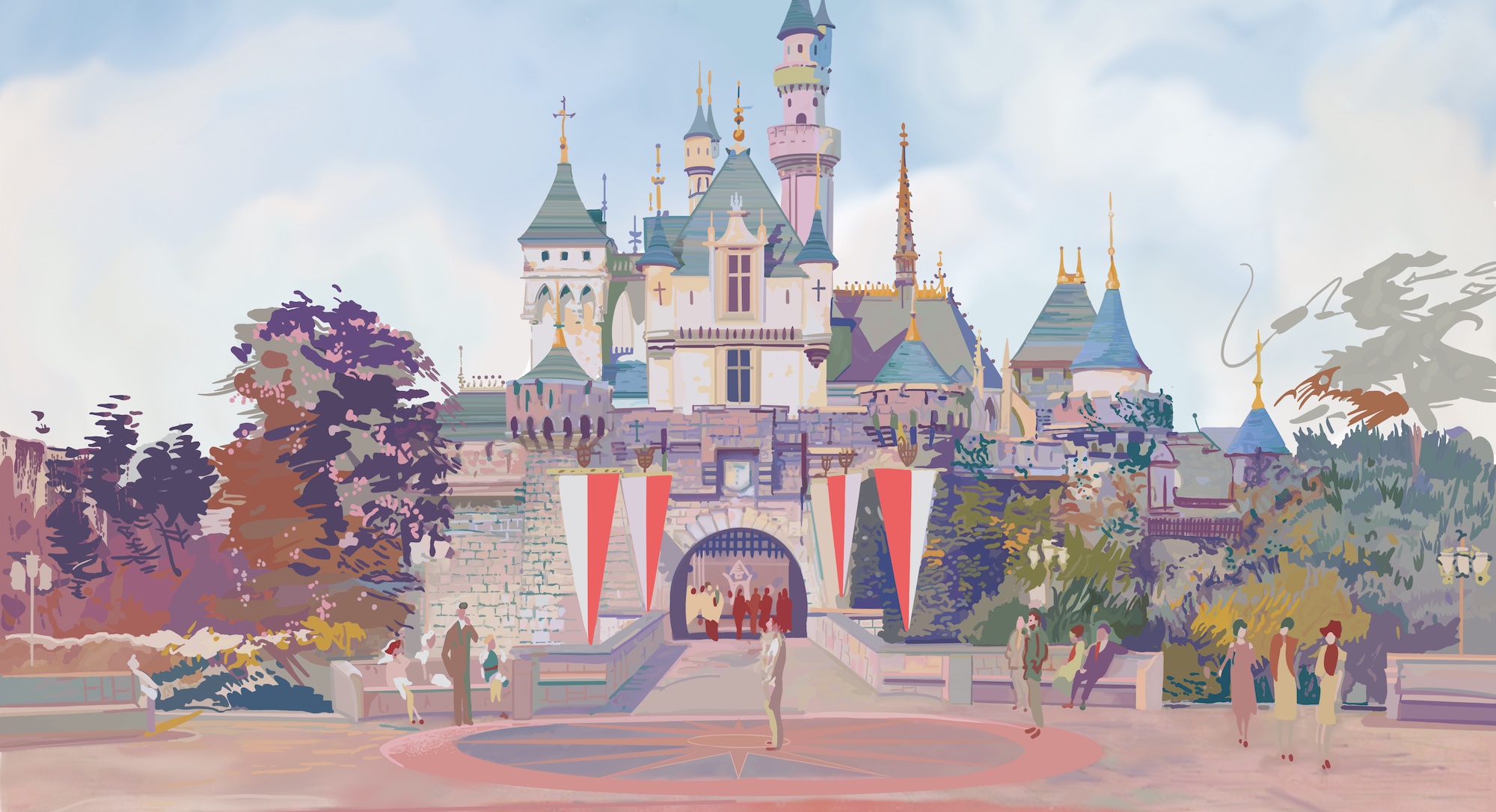“P-Ticket” Rides (2006 – 2010)
After Disney’s full-out acquisition of Pixar in 2006, a wave of “P-Ticket” rides spread across Disney Parks. Why “P”-Tickets? Ranging from small encounters to full-on anchor attractions, this period of Pixar’s integration was largely made of a few new additions, and a wave of cloned attractions across the globe. Now that Disney and Pixar’s future was assured, Pixar characters were slowly folded into the parks in classic dark rides, new-age attractions, and headliners. As might be expected with a quick roll-out of popular properties, there wasn’t always a lot of care or thought put into these “P-Tickets” placements, which is why some are tied to the frustration of fans…
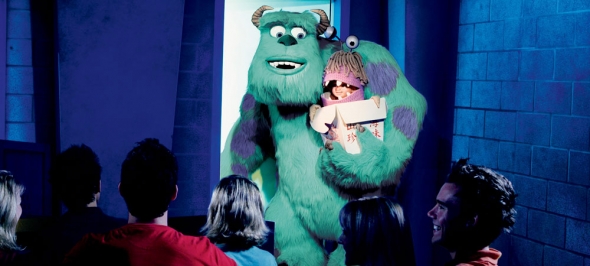
In 2006, Monsters Inc.: Mike and Sulley to the Rescue opened at Disney’s California Adventure, replacing the abysmal ride that some call Disney’s worst dark ride ever – the Declassified Disaster: Superstar Limo. The relatively simple, Fantasyland-style dark ride set in the park’s Hollywood “studio” backlot area pre-dated the park’s $1.2 billion facelift, but served to bolster its family-friendly offerings just as “a bug’s land” had and remains a gentle, ambivalent aside for families.
In 2007, a handful of Pixar attractions (no doubt green-lit after the 2006 purchase of the studio) came online. For example, Monsters Inc. Laugh Floor came to Magic Kingdom, replacing the Lost Legend: The Timekeeper. The attraction – another live-puppeted production like Turtle Talk – invites guests into a Tomorrowland night club where guest-submitted jokes told by comedy club monsters are meant to gather “laughs” to power Monstropolis.
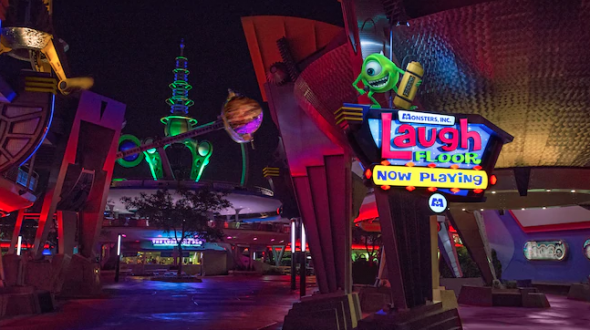
Okay, so Monsters Inc. made even less sense in Tomorrowland than Buzz Lightyear and Toy Story 2 had ten years earlier, but by that time, Tomorrowland was largely seen as a lost cause anyway. The careful “world-building” that had accompanied New Tomorrowland in 1994 (with Timekeeper, Alien Encounter, and more all united under one overarching continuity) had fallen, so Monsters Inc. set alongside Toy Story 2 and Lilo and Stitch was just a sign of the times.
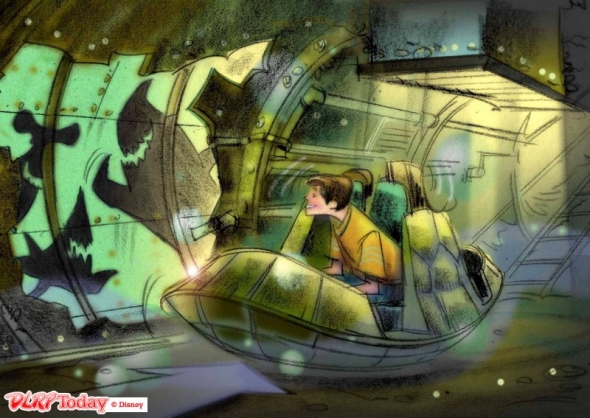
That same year, Pixar served as the backbone for an extension of Disney’s most pathetic theme park ever, the Declassified Disaster: Walt Disney Studios in Paris. There, an expansion of the ‘Toon Studio’ area added a flat ride themed to Cars and a more elaborate indoor Crush’s Coaster based on Finding Nemo.
Speaking of Nemo, for years, Disney had been looking at the potential of “plussing” Epcot’s “sterile, scientific” Future World with characters as a solution to its admittedly aging appeal. 2004’s Turtle Talk with Crush had been a proof of concept, and now it was time for the Lost Legend: The Living Seas to become home to the cartoon clownfish.
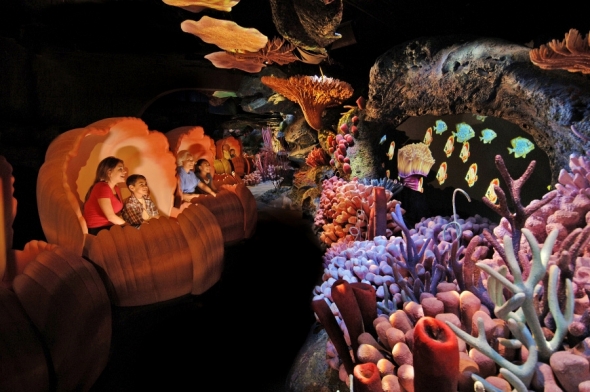
Disney’s new ownership of Pixar meant that the billion-dollar Finding Nemo could take up full residence in the Future World pavilion, and in 2007 The Living Seas became The Seas with Nemo and Friends. One of the first (and most egregious) character “invasions” in a park specifically designed without characters, The Seas with Nemo and Friends is admittedly an odd juxtaposition of the whimsical, colorful, Australia-set adventure film with a distinctly-80s Seabase interior of the pavilion.
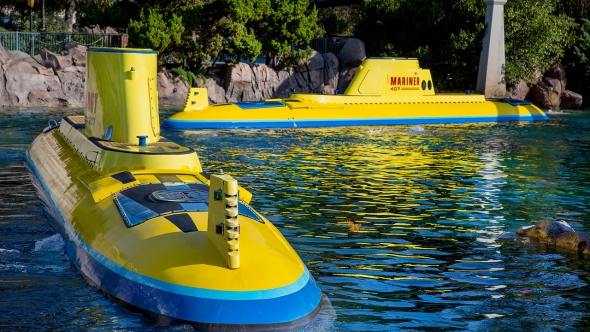
In the third Nemo attraction for the year, Disneyland’s Submarine Voyage (a Walt-original dating to 1959) had been closed by Eisner’s penny-pinching regime back in 1998. Just as Magic Kingdom’s version of the ride was ultimately sunk for its high operating cost and low capacity, fans simply expected that Disneyland’s subs would eventually bite the dust… especially when a briefly-planned Atlantis: The Lost Empire overlay was axed (for obvious reasons). But in 2007, the Finding Nemo Submarine Voyage surfaced, saving the historic ride for a new generation… even if it was yet another chip away at Tomorrowland’s foundation.
(In 2017, Nemo would overtake StormRider at Tokyo DisneySea as well, transforming the massive STAR-TOURS-style simulator into Nemo and Friends SeaRider.)
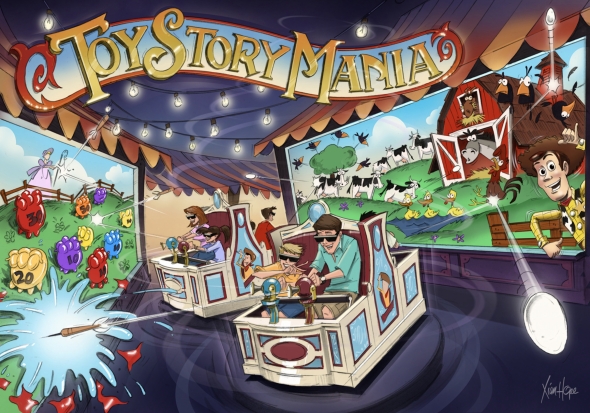
A final (and perhaps most noteworthy) attraction of the “P-Ticket” era was Toy Story Midway Mania! The ride opened in 2008 at Disney’s Hollywood Studios in the red-bricked Pixar Place land, meant to emulate the look and feel of Pixar’s Emeryville, California campus. A few weeks later, a clone of the ride opened at Disney California Adventure, dressed in the elegant trappings of a Victorian boardwalk – part of the park’s rebirth and transformation of Paradise Pier from a sleazy modern carnival to a turn-of-the-century boardwalk. (A third Midway Mania opened at Tokyo DisneySea in 2012 in even more elaborate dressing: an east coast electric trolley park.)
Pixarlands (2012 – Today)
It just so happens that the rise of Pixar parallels a big change in themed entertainment design as a whole. In 2007, the announcement of the Wizarding World of Harry Potter at Universal’s Islands of Adventure proved that the future of theme parks lay not in E-(or “P”-)Ticket rides, but in lands. Its 2010 opening only further exemplified that a new standard had been set. Guests wanted to do more than ride a ride with their favorite characters; they wanted to live their lives, step into their worlds, eat their food, and (if operators chose the right property) buy their stuff.
The world of Harry Potter was a natural fit, bringing to life the snow-capped village of Hogsmeade nestled into the Scottish countryside beneath the iconic Hogwarts School of Witchcraft and Wizardry reigning overhead.
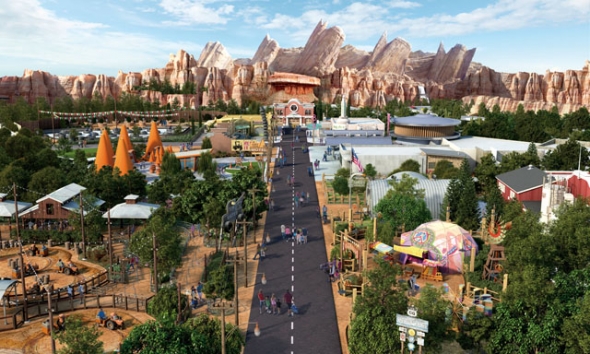
But following on the coattails of the Wizarding World’s announcement, Disney had one of their own. The long-suffering Disney’s California Adventure would undergo that $1.2 billion reconstruction, fixing the park’s fatal flaw in each of its themed lands. But of great importance, the park would also add a new, from-scratch land: CARS LAND. Cars Land would bring the remote Route 66 desert town of Radiator Springs to life exactly as it had been seen in the films. Forget the caricatured flat ride from Walt Disney Studios in Paris… Cars Land was the real deal, with two fully integrated family rides and the E-Ticket Modern Marvel: Radiator Springs Racers.
And like the Wizarding World, guests would no doubt want to shop at Ramone’s Body Shop; dine at Flo’s V8 Café; swing by the Cozy Cone Motel. It worked. Despite being based on Pixar’s 16th highest grossing film (out of 19), Cars Land was a hit, the highlight of the “new” park we explored in Disney’s California (Mis)adventure: Part II.
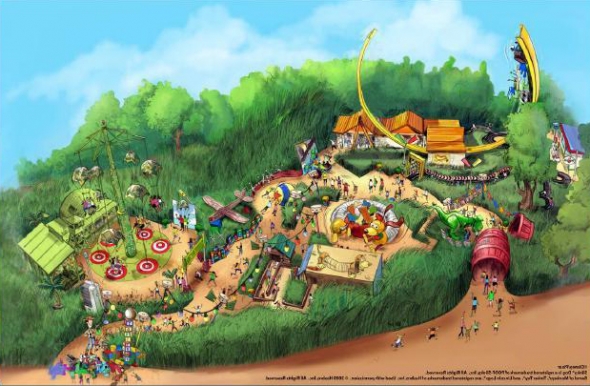
Though much less ambitious, TOY STORY LANDs opened across Disney Resorts, too – not coincidentally, at four parks deemed in need of additional ride capacity, stat: Walt Disney Studios Park (2010), Hong Kong Disneyland (2011), and Shanghai Disneyland & Disney’s Hollywood Studios (both 2018).
While each Toy Story Land has a unique set of rides (with Florida’s being the most ambitious by nature of having a family roller coaster and Midway Mania, rerouted from its old Pixar Place entrance), Toy Story Lands are mostly recognized by fans as simple, fast, “cheap and cheerful” additions that quickly expand ride lineups and family offerings.
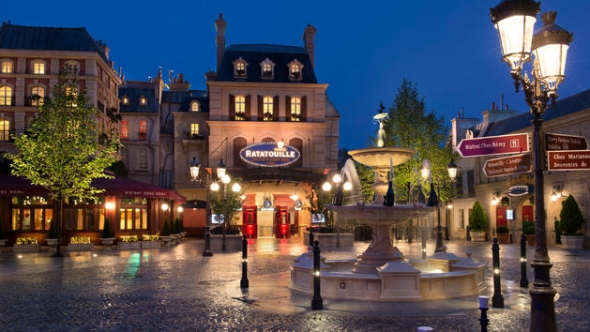
In 2014, the same underbuilt Walt Disney Studios Park at Disneyland Paris got another shot in the arm by way of one of Disney’s most high-tech rides yet, the Modern Marvel: Ratatouille – L’Aventure Totalement Toquée de Rémy. But more than just an E-Ticket ride inside of a beige studio warehouse, Ratatouille turned the Studio park’s failing foundation on its head by being placed in a new Parisian courtyard with authenthic atmosphere, food, wine, and shops.
Though small, this new Ratatouille-themed “mini-land” sets the stage for the park’s next era of transformation (when it’ll be joined by lands dedicated to Marvel, Star Wars, and Frozen, each continuing Ratatouille’s tradition of undoing the park’s dated “studio” style). In 2021, the nameless Ratatouille mini-land and its neighboring Toy Story Land were redistricted into a new, standalone WORLDS OF PIXAR area, complete with a flashy marketing campaign.
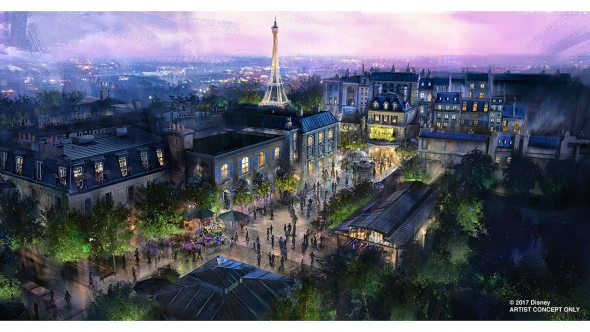
Back at Walt Disney World, a copy of the Ratatouille ride and a new patisserie opened October 1, 2021 in a custom-built courtyard within Epcot’s France pavilion. Though less controversial than Frozen replacing the Lost Legend: Maelstrom that once stood in the park’s Norway pavilion, the Ratatouille ride nonetheless continues the strategy of inserting Disney and Pixar into Epcot, which was once strictly off-limits for characters. Whether that’s brilliant or blasphemous, we wouldn’t dare argue here.
Among the most recent Pixar pushes at Disney Parks is perhaps the oddest one. Disney California Adventure’s Paradise Pier (remember, recently renovated as part of the park’s epic rebirth to more closely resemble a historic, reverent, idealized, turn-of-the-century boardwalk with a few classic, pie-eyed Disney characters) got a third facelift in 2018, becoming the unusually ecclectic Pixar Pier.
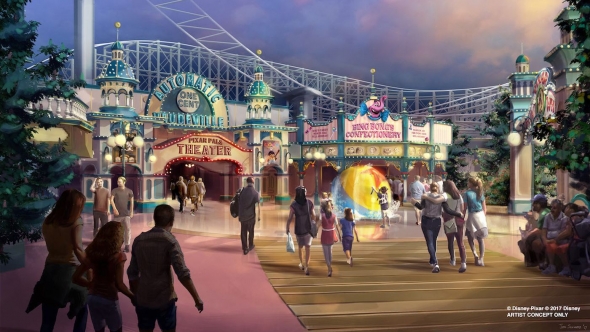
Rather than being an immersive, Wizarding World style land themed to a single Pixar intellectual property, Pixar Pier is themed to Pixar’s brand and its catalogue as a whole.
What it amounted to is an odd double-dipping situation wherein Imagineers seemed to push the pier even further toward that elegant, timeless, beautiful “Victorian” look and feel… while simultaneously slapping Pixar brands on the rides, adding the Animatronic Luxo Jr. lamp to disconnectedly stand over the pier’s entrance, and creating four dissimilar Pixar “neighborhoods” (a fancy marketing cop-out for a mid-century modern Incredibles ride next to a Victorian-styled Midway Mania next to Inside Out being unceremoniously stuck on a carnival spinner).
Pixar Pier actually seems to go against the “Wizarding-World” model. If there’s a “story” to be told by Pixar Pier, it appears to be “The modern Walt Disney Company owns a California boardwalk and has decided to overlay its popular Pixar franchises overtop of the rides and food stands there.”
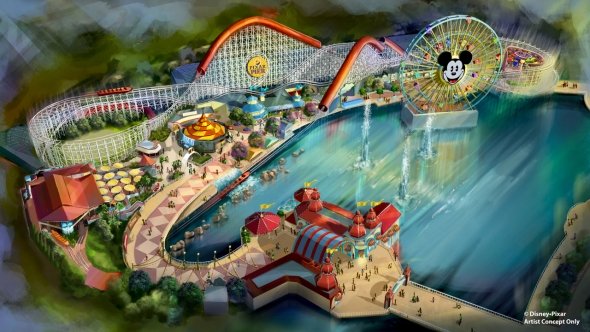
So while guests queue to buy “Jack Jack’s Cookie Num Nums” (from The Incredibles) or “Adorable Snowman’s Frosted Treats” (from Monsters Inc. – “It’s lemon!”), themed entertainment insiders can’t help but balk at the unusual setting and “story” that seems so antithetical to the billion dollars Disney just spent to re-do the park and cement its careful, historic Californian narrative.
Attraction-wise, Pixar Pier still includes Toy Story Midway Mania as well as the Incredicoaster (achieved with a disappointingly low-budget overlay to the park’s classic California Screamin’) and (most curiously) the Pixar Pal-a-Round – the new name for the land’s towering Ferris wheel that continues to feature a pie-eyed Mickey on its face, leading to Mickey Mouse reigning over Pixar Pier… huh?
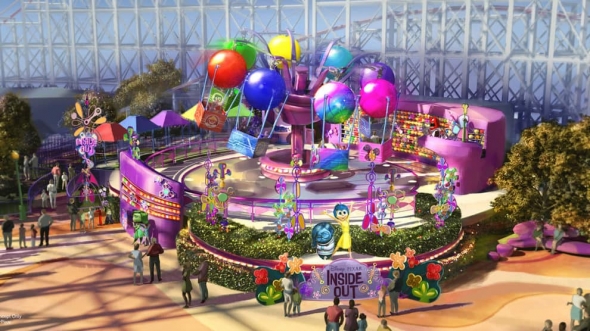
In a phase II expansion in 2019, they were joined by Jessie’s Critter Carousel, plus the Inside Out Emotional Whirlwind – a carnival spinner ride (reclaimed from the closed “bug’s land”). Altogether, the latter exemplifies most Disney Parks fans’ feelings toward the land. One of the most emotional and beloved Pixar films of all time receives not a heart-wrenching dark ride through the psyche but… a relocated and re-stickered yo-yo swing?
Pixar Parks
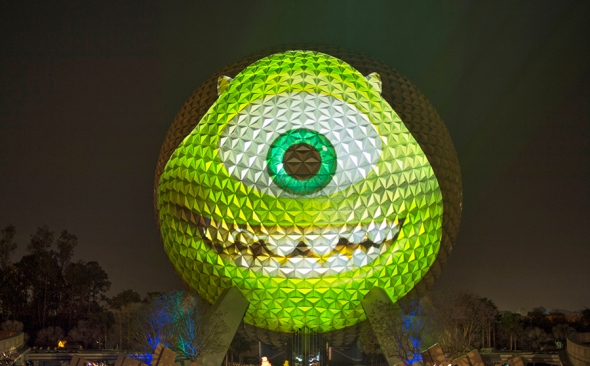
In the 2010s alone, Bob Iger oversaw acquisitions of Pixar, Marvel, Lucasfilm, and 20th Century Studios, and while all are seeing increased presence in Disney Parks, there’s just no denying that Pixar continues to rise (albeit, with Disney Animation itself coming a pronounced comeback alongside it, and in computer animation to boot).
In the end, does it matter? Pixar is Disney, after all. But increasingly, fans wonder if Pixar’s booming success has overshadowed the parks’ classics and “authentic” Disney characters. And even ardent Pixar apologists must sometimes wonder: do Monsters Inc. and Toy Story belong in Tomorrowland? Should Woody and Jessie be wandering around Frontierland? Shouldn’t Pixar Pier be a temporary overlay rather than a permanent (and perhaps, short-sighted) installation?
From humble origins to a dominant box office power increasingly pulsed into Disney Parks, Pixar may very well be the future of Imagineering… But should it be?
What does the future of Pixar in Disney Parks look like? Think “to infinity and beyond.”
On the last page, we’ll include a year-by-year breakdown of Pixar attractions at Disney Parks.
